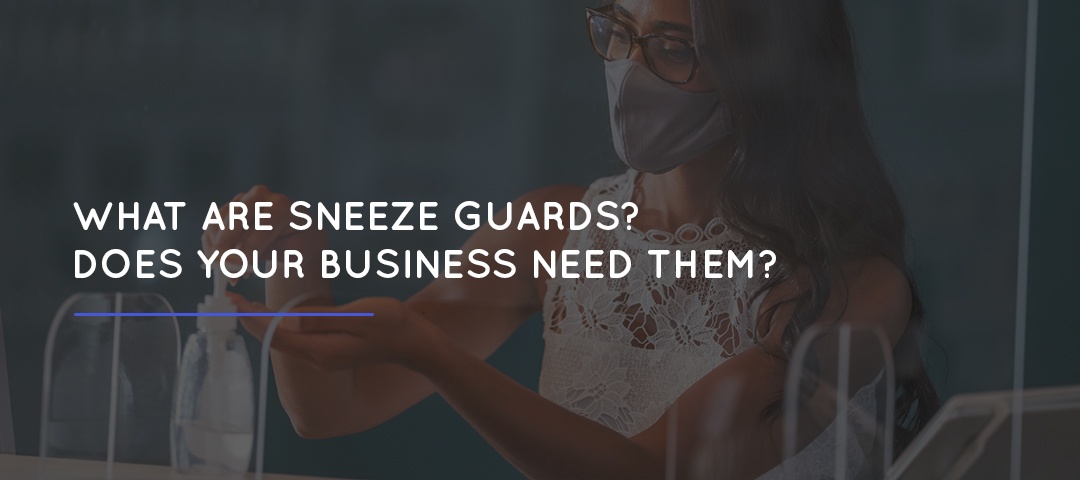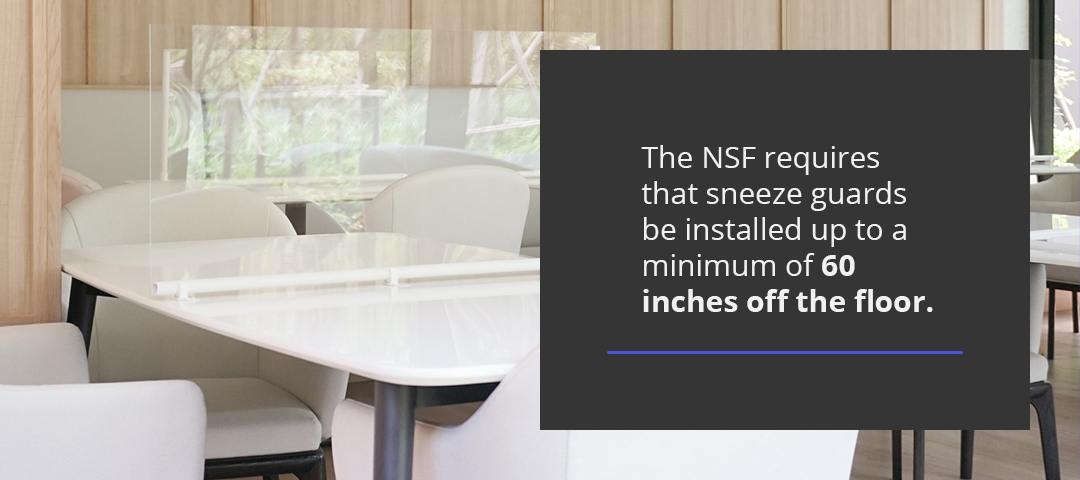Face Smashed Against Sneeze Guard Funny
What Are Sneeze Guards?
Posted on: February 1, 2021 in COVID-19
Share:

As the COVID-19 pandemic continues, businesses are looking for ways to make customers and employees feel safe and comfortable in the workplace. Sneeze guards can reduce the transfer of droplets from coughing or sneezing even when face masks and social distancing are implemented.
Businesses can integrate various sneeze guard materials, installation types and designs into any environment's decor. Whether temporary, portable or permanent, sneeze guards are an essential addition to today's business environment where customers and clients still need to interact closely but safely.
Table of Contents
- Do Sneeze Guards Work?
- How Are Sneeze Guards Made and Customized?
- Sneeze Guard Requirements
- How to Install a Sneeze Guard
- How Do Different Businesses Use Sneeze Guards?
- Why Your Business Needs to Use Sneeze Guards
- Choose Maintco Corp for High-Quality Plexiglass Sneeze Shields
Do Sneeze Guards Work?
During the coronavirus pandemic, along with face masks, the Centers for Disease Control and Prevention (CDC) recommends keeping a minimum of 6 feet social distance between people at all times. However, in many daily situations, keeping 6 feet away from others isn't possible. Simple tasks like visiting a bank teller or picking up a prescription require close personal interaction between customers and staff. For these situations, employers need to ensure as much exposure protection as possible for workers and customers.
To provide further protection than social distancing and face masks alone, the Occupational Safety and Health Administration (OSHA) recommends installing clear plastic sneeze guards to slow and stop the spread of droplets between individuals. The benefit of sneeze guards is that while they provide a barrier to prevent the spread of droplets, customers and workers can still see through them, allowing everyone to interact normally.
For years, transparent shields have been required in the food industry to shield food products from contamination by customers and staff. The National Sanitation Foundation (NSF) requires unpackaged food to be shielded from customers' mouths to reduce droplet transfer.
In 1959, inventor Johnny Garneau created the "food service table" and fitted it with a sneeze guard. Although Garneau was an admitted germaphobe and made his invention because he was uncomfortable with people getting too close to the food and smelling it, his invention led the way in food service sanitation guard and barrier technology. By 1976, the Food and Drug Administration (FDA) regulated food shields similar to Garneau's designed his prototype.
You can view sneeze guards as a natural continuation from food service guards. Establishing a barrier so people can't get too close to one another, as well as stopping droplets from coughs and sneezes, provides a much-needed increase in safety for workers and customers across a wide range of industries.
How Are Sneeze Guards Made and Customized?
Several different types of sneeze guard materials are available, but they all serve the same function. Most materials provide a barrier between customers and workers interacting face-to-face and prevent the spread of droplets from coughs and sneezes without obscuring sightlines. The choice of material depends on cost, available supply, design appearance and many other factors, all individual to the business in question.
Acrylic Plastic Barriers

Acrylic plastics are made from acrylic acid. The most popular version is polymethyl methacrylate or PMMA, which is sold under well-known and reputable brand names like Plexiglass, Lucite, Perspex and Crystallite. Many industries rely on PMMA for applications like airplane windows, skylights and automotive light lenses. Acrylic is preferred due to mechanical and chemical properties that allow it to be colored, molded, drilled and formed.
Acrylic plastic polymer is made by combining methyl methacrylate with an organic peroxide catalyst in a mold that is then sealed and heated. Because of this manufacturing process, many different shapes can be made, which is advantageous for businesses wanting custom sneeze guards.
Polycarbonate Plastic Barriers
Polycarbonate shares many similar properties as acrylic plastics and PMMA but is typically much stronger. It's used in safety helmets, bulletproof glass and car headlight lenses.
Polycarbonate is also more expensive than other types of polymers, and for sneeze guards, it's generally excessive. Situations where it may be favorable include bank teller stations, convenience stores and parking garage booths.
Glass Barriers
Glass barriers are popular in settings where you need a permanent barrier, such as in restaurant buffets, balcony barriers or windows. Glass is typically much heavier than PMMA or polycarbonate plastics, so it requires stronger installation methods like permanent metal supports, which can't be suspended from the ceiling easily.
Glass is also much more fragile than plastic and more expensive to customize and replace if broken. The installation costs are also higher, as businesses need to hire professional installers to install them safely and correctly.
Mounting Sneeze Guards
As with sneeze guard materials, many mounting options for sneeze guards are also available, most of which depend on the application and intended use. During the COVID-19 pandemic, most sneeze barriers are the tabletop kind, which is a freestanding solution and can be moved around easily to suit workplace needs. More permanent tabletop installations using glass barriers and heavier metal bases can be secured to tabletops and counters to provide a more permanent fixture for long-term use.
Wall- or booth-seating-mounted sneeze guards separate people while seated, such as in a restaurant or waiting area. They can also provide additional privacy by varying the level of opacity or adding color.
Sneeze Guard Requirements
In their 2013 Food Guide, the FDA specifies the requirement for sneeze barriers to protect food from contamination. However, there are currently no laws requiring people's protection from droplet contamination beyond the CDC's mandated mask-wearing and social distancing in public spaces. The CDC does recommend that everyone take any and all precautions to protect themselves from the spread of the virus. This would include installing sneeze guards wherever human interactions must occur and where a 6-foot social distance cannot be maintained.

How high should a sneeze guard be? The NSF requires that sneeze guards be installed up to a minimum of 60 inches off the floor. This guideline is meant to ensure food products are shielded from a direct line-of-sight of a customer's mouth if they were to cough or sneeze. This 60-inch height also ensures that the sneeze guard is high enough to block taller people.
The type of material is also important. According to the NSF, sneeze guards need to be made of materials that do not scratch easily. Tiny scratches on the surface of the sneeze guard can harbor bacteria and viruses. The sneeze guard must also be designed to eliminate crevasses and areas that could collect and trap unwanted droplets or other contaminants. Materials such as acrylic, polycarbonate and glass are ideal in such situations because of their hardness and resistance to scratching.
Regarding the thickness of the sneeze guard, the material needs to be thin enough to be transparent to allow customers and workers to see each other during their interaction. But the guard should also be strong enough to resist cracking or bending if some force is applied to it for whatever reason.
It's also necessary to make sure that heavier materials, such as glass, are firmly secured to surfaces so they don't tip over and hurt someone or fall to the ground and break.
How to Install a Sneeze Guard
You have many options for installing sneeze guards, depending on the space. You can use both permanent and temporary options to suit any situation, room type and aesthetic requirement.
The first thing you need to decide is if the sneeze guard is going to be permanent or temporary. A permanent installation should be professionally installed and made from scratch-resistant and tough materials so it will remain in-tact and sturdy over its lifetime. However, when it comes to installation, temporary sneeze guards are beneficial because they're typically light and portable, meaning you can move them around your business to suit your needs.
One of the most popular installation options is to hang a sneeze guard from the ceiling. A hanging sneeze guard is a good alternative to installing a stand on the counter because it saves space, and you won't need to drill into your surface to secure it.
Various suspension systems are available for acrylic or polycarbonate sneeze shields. However, these options depend on whether you have a drywall ceiling, suspended ceiling or concrete slab above. If there is a concrete slab above, you will need to drill into it and use metal anchors to secure the sneeze guard. A drywall ceiling requires drilling into the ceiling and placing hooks, which is far less intensive than drilling into a concrete slab. Lastly, suspended ceiling systems, such as T-bar ceilings, offer the most versatility in hanging a plastic sneeze shield.
Once your hooks are installed in your ceiling or concrete slab above, you will need to choose a suspension method using either a cable, bar or string to connect to your sneeze shield. The weight of your sneeze shield will determine which suspension system to use. Because of this, it's recommended to use small panels no larger than 20 square feet when using lighter gauge wire or fishing line to hang the sneeze guard.
Lastly, when attaching the wire, string or cable to the sneeze shield, you will need to choose to drill holes in the sneeze shield or use a banner hanger. Drilling holes in the sneeze guard is quicker and easier but usually doesn't present as nicely as a banner hanger.
How Do Different Businesses Use Sneeze Guards?

Sneeze guards are most commonly associated with restaurants. Although sneeze shields have been used for many decades in the food service industry, many other sectors are starting to use them to reduce droplet transfer between customers and workers. Most businesses realize that sneeze guards are a good investment in their facility and, as a result, are choosing to install permanent, high-quality sneeze guards rather than temporary solutions. Some businesses that can benefit from sneeze guards include:
- Banks
- Pharmacies
- Hospitals and clinics
- Car dealerships
- Gas stations
- Retail shops
- Grocery and convenience stores
- Restaurants and coffee shops
Business owners know that the comfort and safety of sneeze shields are more beneficial than ever for their customers and workers. Restaurant sneeze guards already protect food from contamination. However, you now see these establishments implementing even more measures like installing sneeze shields at point of sale terminals and other areas where patrons congregate. Similarly, businesses that typically see people closer than 6 feet together only at checkout lines, like clothing and merchandise stores, choose to install sneeze guards to protect their employees and customers during checkout.
Car dealerships and taxis now use custom plastic sneeze guards to separate customers and drivers during car rides, even when masks are already being worn, to increase the safety and comfort of everyone involved.
Likewise, cafeterias and restaurants now install sneeze guards in areas where their seating layouts can't accommodate the 6-foot social distancing guidelines. This allows customers to eat and drink with their masks off and still feel protected.
Business owners must also keep in mind that cleaning and maintaining sneeze guards are essential to preserving their effectiveness and longevity. Shields must be routinely cleaned with appropriate cleaning products to maintain their transparency and keep them free of viruses and other contaminants. Glass sneeze guards can be cleaned with products specially formulated to leave a streak-free finish and kill viruses and bacteria. Similarly, other products are specifically made to clean transparent plastics that also eliminate viruses, bacteria and other pathogens.
Choosing sneeze guards made of hard materials is also beneficial, as they're less likely to scratch, which can otherwise create pockets for contaminants to accumulate.
Why Your Business Needs to Use Sneeze Guards
The coronavirus pandemic has made us aware that close human contact can easily transfer viruses and other germs. Most customers and clients feel much safer when they can keep their distance during these uncertain times. However, there are instances in many businesses where this can't occur, such as at point-of-sale terminals, taxi rides and grocery store checkout lanes.
Although there are no laws requiring sneeze guards to be in place in these instances, it's a wise choice to install them to make your customers feel more comfortable and safe while they do business with you.
The CDC recommends taking every precaution we can to ensure there is less droplet transmission between people. It's in all of our best interests to work together and do our part. Businesses that choose to install sneeze shields will establish a reputation for safety and comfort. Food service businesses will avoid fines from inspectors and have higher levels of cleanliness and organization. Employees will feel much safer knowing that their employer chose to install a sneeze guard to protect them, which is an essential investment during the pandemic.
Choose Maintco Corp for High-Quality Plexiglass Sneeze Shields
With the COVID-19 pandemic making us more health-conscious than ever, employers must take every precaution they can to promote safety and comfort in their businesses. Sneeze guards are an excellent way to dramatically reduce the transference of droplets from coughing or sneezing, whether or not customers and employees are wearing face masks and maintaining 6-foot social distance.
Whether permanent or temporary and portable installations, sneeze guards come in a wide variety to suit every need and environment. Maintco Corp provides a full range of customizable options that can make your customers and employees feel more comfortable and safe during the coronavirus pandemic and beyond. To discover how we can create a custom-fabricated sneeze guard to protect your staff and customers, contact us online or call us at 818.276.6300.

Source: https://maintco.com/news-media/sneeze-guard-guide